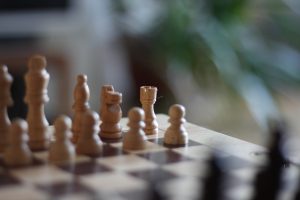Guest Post by: Keir Calvert, Royal Oak Alternate Program
I was a terrible math student. In fact, halfway through Math 12, I dropped out. It is the greatest irony that I am now the math teacher with the Royal Oak Alternate Program. Similar to my own high school experience, the majority of the students at Royal Oak struggle with learning the concepts in the curriculum. As a result of their perceived failures, students frequently use the word “hate” to describe their attitudes about the subject as a whole. In recognizing this pattern with incoming students, my search began for an engaging and accessible way to teach Math 11 A&W. 
Sitting at my desk one day, my eyes glanced around the classroom. Settling over a lone chessboard collecting dust on a bookshelf, I recalled my fondness of playing the game as a teenager and thought, “there must be some way to squeeze math out of this.” Eventually, realizing that the board was similar to graphing paper opened up new possibilities as I considered ways to use chess to teach a graphical representations unit. The students were inquisitive and engaged, and once they had learned the game I began to see other uses of chess to teach scale representations, Pythagorean Theorem, trigonometry, surface area and volume, and slope & rate of change. Chess is now used to teach approximately 60% of the course at Royal Oak. Most students that enter the program have little to no knowledge of chess. Teaching them the game first and the mathematical applications secondly allows for play and ‘gaming’ to be at the forefront of their learning pathway. Chess has become a favorable pastime, and the students will frequently ask to play in their downtime. They ask to do math instead of avoid it. There are benefits beyond math proficiency that come with the game. Chess exercises their patience, concentration, strategy building, and ability to look at a situation from multiple perspectives. Students are engaged in positive social interactions where interpersonal skills and critical thinking is necessary. Chess has not only transformed my teaching practices and the attitude about learning math in the class, it acts as a way to connect through gaming.
